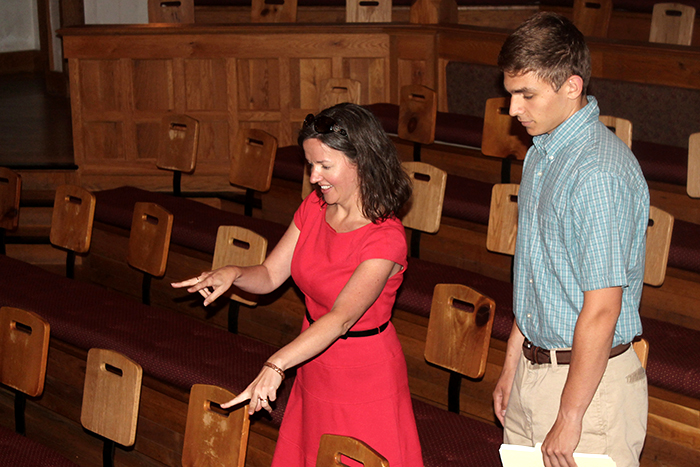Applied Math Project Takes on Shakespeare

Ryan Poffenbarger ’16 and the American Shakespeare Center’s Amy Wratchford confer at Blackfriars Playhouse. -- VMI Photo by Chris Floyd.
In the world of academia, Shakespeare and math do not seem to have much in common. But in the real world this summer, the two seeming academic opposites walked hand in hand.
The Applied and Industrial Mathematics program at VMI made sure of that when cadet Ryan Poffenbarger ’16 was assigned the task of crunching numbers for the American Shakespeare Center in Staunton. Thanks to his research, the organization now has a better grasp on how to market its product.
“It’s going to help us target our marketing in a much better way rather than just making queries,” said Amy Wratchford, the managing director for the center. “We have all of this data we don’t have the time or expertise to dig into. They helped us make sense of all of our data.”
Through his analysis, Poffenbarger uncovered a number of trends at the center and the Blackfriars Playhouse, including the number of customers who attended multiple performances, the number who tended to return each year, and the number of seats that sold the most often. He presented this information to Wratchford in June.
“It was a lot of detective work,” Poffenbarger said. “They know the business part of the Shakespeare Center better than I do, so I was looking for things that would be related to making business decisions for them.”
“That’s the role of the analyst: look at the numbers, do the technical stuff, and help them make smart decisions,” said Maj. John David, assistant professor of applied mathematics and AIM coordinator. “They are ultimately going to make the decision about what to do. We just try to help them make fewer guesses.”
According to Maj. Geoff Cox, also an assistant professor of applied mathematics, who served as the cadet’s supervisor, the role of the data analyst is only to crunch the numbers, not make recommendations.
“There is a lot of uncertainty,” Cox said. “You want to tell them, ‘This is what we found; here’s a possible interpretation.’ But there are many others.”
Poffenbarger’s project was one of three by cadets associated with AIM. Another was with an investment firm in Lexington, while the third was with a local manufacturer. The AIM program is a collaboration of the VMI Center for Undergraduate Research, the applied math department, and external clients. AIM generates revenue from the client, which pays the cadet’s stipend, and VCUR supports the professor’s stipend via its Summer Undergraduate Research Institute.
Poffenbarger was the 17th cadet to work with David over the last three years. He learned a great deal from the experience, and not just in math.
“The one thing I learned the most was programming,” said Poffenbarger, who noted that he often had to reformat the data sent to him from the Shakespeare Center. “I went from zero programming experience, aside from HTML, to writing what I thought were pretty complex solutions to a formatting problem.”
David became aware of the predicament at the Shakespeare Center while he was giving a presentation of his findings from an AIM project for the United Way. Wratchford happened to be in attendance, and she immediately began thinking of how the VMI program could help her outfit.
“She thought it was a really cool idea,” said David. “She was definitely excited about what quantitative thinking can do to make a place work better.”
And that is the purpose of AIM. So often, it is hard to visualize how higher math can be beneficial in real-world situations; AIM takes care of that.
“It’s about going out and getting real-world problems from government, business, [and] industry, [and] bringing them back to have our VMI cadets solve them,” said David.
“It’s a good contrast from the classroom,” added Cox.
Did VMI’s AIM program help? Wratchford seemed encouraged by the findings.
“We’ve been very pleased,” she said. “They [helped] us get our vision wrapped around our patron and donor database.”
And the AIM team proved that maybe Shakespeare and mathematics do belong together.
.svg)
.png)
